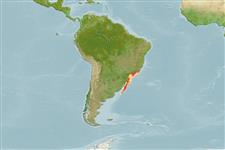Malacostraca |
Decapoda |
Nephropidae
Environment: milieu / climate zone / depth range / distribution range
Ecology
Benthic; depth range 50 - 150 m (Ref. 101590). Subtropical; 22°S - 37°S, 59°W - 42°W (Ref. 4)
Western Atlantic: off the east coast of South America between 23 S (off Rio de Janeiro, Brazil) and 38 S (off Buenos Aires Province, Argentina).
Length at first maturity / Size / Weight / Age
Maturity: Lm ? range ? - ? cm Max length : 18.0 cm TL male/unsexed; (Ref. 122061)
It has a total body length (adult specimen) ranging between 11 and 18 cm; and carapace length between 5 and 18 cm (Ref. 4). Maximum depth from Ref 4. Occurs at depths between 50 and 150 m deep (Ref. 4). Found on the shelf break (Ref. 106830).
Life cycle and mating behavior
Maturity | Reproduction | Spawning | Eggs | Fecundity | Larvae
Members of the order Decapoda are mostly gonochoric. Mating behavior: Precopulatory courtship ritual is common (through olfactory and tactile cues); usually indirect sperm transfer.
Holthuis, L.B. 1991 FAO Species Catalogue. Vol. 13. Marine lobsters of the world. An annotated and illustrated catalogue of species of interest to fisheries known to date. FAO Fish. Synop. 125(13):292p. Rome: FAO. (Ref. 4)
IUCN Red List Status
(Ref. 130435: Version 2025-1)
CITES status (Ref. 108899)
Not Evaluated
Not Evaluated
Threat to humans
Human uses
Fisheries: minor commercial
| FishSource |
Tools
More information
Trophic EcologyFood items (preys)
Diet composition
Food consumption
Predators
Life cycleReproductionMaturityFecunditySpawningEggsEgg developmentLarvae PhysiologyOxygen consumption
Human RelatedStamps, coins, misc.
Internet sources
Estimates based on models
Fishing Vulnerability
Low vulnerability (10 of 100).
